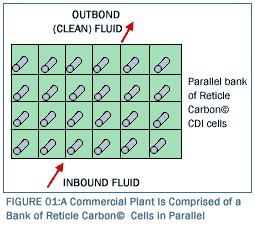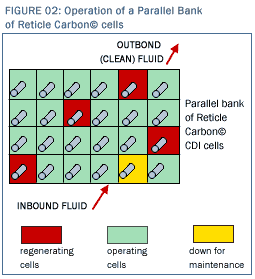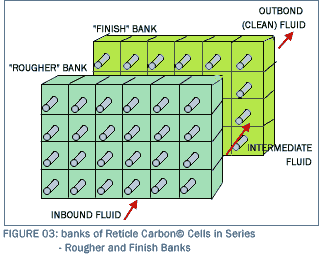
|
|
|
|
|
|
|
|
 |
|
|
|
||||
|
|
|
||||
     |
Reliability Through Modularity and Parallelism at Low Cost In real world applications, two CDI systems are built in parallel so that while one system is being flushed, the redundant, parallel system can continue to operate, thus allowing for continuous operation.) Figure 1 illustrates this parallel implementation of modular Reticle Carbonİ CDI cells. Such parallel implementation is a immeasurably profound benefit as compared with single, large, integrated, nonparallel designs. 1. The size of a commercial plant can be increased by simply adding more "standardized" cells in parallel. This is a huge benefit, for it means that each individual cell need not be scaled up but rather that entire plants can be scaled up merely by adding cells in parallel to an existing set of preexisting cells. Relatively easy scaleup is a profound benefit for Reticle, for it eliminates typical scaleup steps that have been difficult or insurmountable with other types of technologies. 2.  Each cell is an "order out of the catalog" standard electrochemical cell and can be built, maintained, and retrofit as an independent entity. A large, integrated plant can have several extra standard cells in inventory which are being repaired, maintained, retrofit, etc. Each cell is an "order out of the catalog" standard electrochemical cell and can be built, maintained, and retrofit as an independent entity. A large, integrated plant can have several extra standard cells in inventory which are being repaired, maintained, retrofit, etc. 3. The "spare parts" inventory can actually be shared among a number of plants. This is a huge benefit, one that is becoming prevalent for example in the electric power industry and the airline industry. There is a regional "pool" or "warehouse" of extra cells (or electric generators or aircraft engines) that are shared among a number of plants in a given region. The aggregate inventory is thereby substantially reduced to each of the individual companies in the region. 4. Parallelism means redundancy, and redundancy means reliability. Industries learned long ago that the very best way to ensure reliability is to have a lot of small components operating in parallel rather than one large part operating along the critical path. For example, IBM discovered years ago that having 30 or more fanfold computer printers on its large mainframe computers was preferable to having 1 large xerographic printer. In the former case, it was virtually certain 2/3 or more of the printers would be running at any given time and thus there was literally zero probability of printer downtime. In the latter case, if the reliability of the large xerographic printer was 0.90, it was down fully 10 percent of the time, and the mainframe had to shut down to accommodate it. The difference in reliability is very large and very important. This is precisely the case with the parallel design conceived for Reticle here. 5. Parallelism through modularity means that improvements in technology or in Reticle Carbonİ can be systematically integrated into plant designs. It is easy to remove an "old technology" module and replace it with a "new technology" module, preserving the integrity of the balance of plant. This means a Reticle Carbonİ plant can be more easily improved than a standard plant in which current technology is deeply embodied. 6. Parallelism means easy maintenance. Cells are pulled from the parallel bank, delivered to the maintenance shop, and maintained in the shop. Shop maintenance has a huge advantage over "in place" maintenance. In place maintenance usually involves downtime, and it often involves worker safety, large equipment, cramped quarters, low productivity, limited access, and other issues, all of which lead to unreliability, accidents, and excessive downtime. With the modular parallel design, one merely pulls one cell from the line, replaces it with an identical cell, takes the pulled cell to the shop, and fixes it there. 7. Because the Reticle cell is modular, we want to "wholesale" it to intermediaries (e.g., construction companies such as Bechtel, Sargent and Lundy) or to water companies (e.g., Nalco, U.S. Filter). Reticle wants to provide detailed operating specifications, and those intermediaries can in turn incorporate Reticle cells into commercial designs they might be selling. 8. The sole, ultimate, and only focus of Reticles business can be the standard cell itself. The Reticle business can be, by virtue of the modular design, to be strongly focused, concentrated, and targeted. The Reticle Carbonİ and its incorporation in a standard cell becomes the objective of the business, and Reticle is able to focus squarely on that objective. It is quite clear that capacitive deionization cells will work with Reticle Carbonİ electrodes for any inorganic dissolved ions or radicals. That technology has been proven and demonstrated years ago, and it works for dissolved organics and biological agents (microorganisms).  Operating a parallel bank of Reticle Carbonİ electrochemical cells offers the advantages illustrated in Figure 2. Notice in the figure, at any given time, there are a number of cells that are deionizing the feedwater, which is directed through those cells. The actively deionizing cells, denoted as green in the figure, contain the serpentine positively and negatively charged electrodes, the feedwater is flowing through them, and they are adsorbing the ions. At the same time, there are a number of cells that are regenerating. (The regenerating cells might actually be hooked up to the generating cells so as to conserve energy.) Wastewater used as motile fluid is being directed into these regenerating cells, denoted as red in the diagram, and their electrodes have been grounded (or directed to other cells or sold to the electrical grid). Operating a parallel bank of Reticle Carbonİ electrochemical cells offers the advantages illustrated in Figure 2. Notice in the figure, at any given time, there are a number of cells that are deionizing the feedwater, which is directed through those cells. The actively deionizing cells, denoted as green in the figure, contain the serpentine positively and negatively charged electrodes, the feedwater is flowing through them, and they are adsorbing the ions. At the same time, there are a number of cells that are regenerating. (The regenerating cells might actually be hooked up to the generating cells so as to conserve energy.) Wastewater used as motile fluid is being directed into these regenerating cells, denoted as red in the diagram, and their electrodes have been grounded (or directed to other cells or sold to the electrical grid).
There is one additional mode of operation we are seeking as well. It is assuredly possible to arrange parallel banks of Reticle Carbonİ cells in series. That is, we would have two banks in  series, each bank containing a number of cells. The first bank would be a "rougher" circuit, taking in a high concentration stream and producing a medium concentration stream. The second bank would be a "finish" circuit, taking in a medium concentration stream and producing a finished product. (Of course, it would be possible to arrange more than two banks in series.) Figure 3 illustrates what a series of two banks in parallel would look like. series, each bank containing a number of cells. The first bank would be a "rougher" circuit, taking in a high concentration stream and producing a medium concentration stream. The second bank would be a "finish" circuit, taking in a medium concentration stream and producing a finished product. (Of course, it would be possible to arrange more than two banks in series.) Figure 3 illustrates what a series of two banks in parallel would look like.
The reason one would want to consider banks (or individual cells) in series is that we might be able to optimize the aggregate size and geometry of the first bank of cells for partial removal of ions from a highly concentrated stream and differently optimize a cell for complete removal of ions from a more dilute stream, i.e., a stream that is the output of the first stage. Aside from size/capacity differences that might be desirable in the "rougher" bank versus the "finish" bank, it may be desirable to optimize surface area in the first stage to maximize flow rate in the first stage so as to create a large volume of intermediate concentration fluid. Thereafter, it might be desirable to optimize the adsorption rate and increase the residence time in the cell in the second phase so as to get more complete ion removal. |
|
copyright reticle 2003 webdesign beatriz alentejano |
|